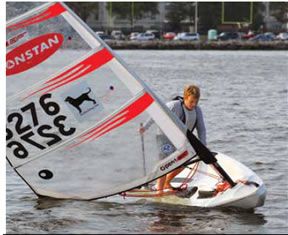Photos by Ralph Naranjo
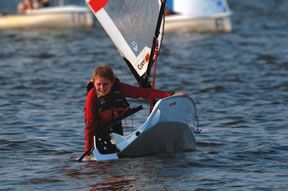
Messing around in small boats is a global theme-one thats embraced by pond-bound pram sailors, river riders, lake voyagers, and all of us who call salt water home. The purpose of this sailing dinghy profile is to highlight seven very interesting little sailboats. Some are new designs, and others have stood the test of time, but all are currently being manufactured, and each drives home just how much fun sailing close to the water can be.
This isn’t a shootout among anorexic speedsters or a report on the best tender that doubles as a sailing dinghy. Its a look at perennials like the Optimist, Sunfish, and Laser-legendary competitors that have helped spawn some of the best sailors in the world. But its also a look at three of the newest entries in the dinghy-sailing circle: Bics Open, Hobies Bravo, and Laser Performances Bug. These agile, new sailing dinghies are chock full of fun and boat-handling features to inspire kids of all ages to go sailing.
Well also take a look at Chesapeake Light Crafts kit approach to getting started-one that offers meaningful lessons and tangible rewards well before the boat ever hits the water.
Open Bic
Scale down an Open 60, add sail technology long favored by windsurfers, and put it into play in a tough thermo-formed hull, and you have the makings for a new kind of watercraft. The result is a very interesting blend of performance and reliability that targets adolescent interest. When all is said and done, Bics boat is more akin to a sit-down windsurfer than a traditional Blue Jay. And like all good boats, its vying for attention not just based on performance, construction quality, and style, but just as importantly, on the price tag stuck to the hull.
The Open Bics light weight and wide, flat stern section means that even small chop can be surfed; and bursts of planing on a reach add a zing factor to dinghy sailing. The Open Bic is already an International Sailing Federation (ISAF)-sanctioned class, and fleets are developing around the US. Another bonus: Its an easily portable boat that can be carried like a windsurfer, adding excitement to a Sunday picnic at the beach.
The thermo-formed polyethylene hull is a modified hard-chine design with lots of beam aft. Sailed flat, the boat is agile enough to surf wavelets, and with a shape thats ergonomically friendly to hiking, the ensuing heel on the upwind leg puts just the right amount of chine into the water. In light air, careful control of heel can significantly reduce wetted surface.
The design team that developed the Open Bic saw it as a transition bridge from Optimist sailing to a more performance-oriented dinghy. An interesting innovation is that the Open Bic can be sailed with an Optimists rig and blades. This buy the hull only approach can be a significant incentive for parents with children outgrowing their Opti as fast as their boat shoes. However it wont be long before the kids want the fully turbo-charged feel delivered with the Open Bics well-shaped 4.5-square-meters rig, sail, and nicely foiled blades.
Bottom line: The Open Bic is fast, agile, and buckets of fun for kids uninspired by sailing in the slow lane.
Bravo
Just when you think that Hobie Cat Co. has covered whats possible in beach-cat innovation, their design/engineering crew comes up with a new twist that reinvents the wheel. The Hobie Bravo is a good case in point.
In a recent visit to Backyard Boats (www.backyardboats.com) in Annapolis, Md., we got a good look at the Bravo. Nearly as narrow as a monohull but still quite stable, this quick-to-launch beach cat packs plenty of get-up-and-go. Its a simple to sail, entry-level boat that fast tracks learning the steer, sheet, and hike trilogy. The boat features a single, midline rudder and roto-molded hulls. The shape of the hulls provides enough lateral plane to allow a crew to make headway to windward.
The narrow (4 feet), 12-foot Bravo uses crew weight and hiking straps to add to the righting moment once the breeze is up. Whats done with webbing on larger cats has been converted to a shallow, rigid deck well on the Bravo. It does raise the weight of the boat to 195 pounds, but it offers comfortable seating plus room for cushions and a cooler. Kids or grown ups can have a Tom Sawyer-Huck Finn type of adventure aboard this fun little sailing machine. Or the family on a beach picnic can set it up and take turns speed reaching along a sandy shoreline.
The furling mast supports a roachy sail with slightly slanted vertical battens, helping to shape the boomless mainsail. The result is convenient sail handling, decent performance, and superior safety. Theres no boom to clobber the crew, and the roller-furled sail and mast are easily stepped in the tripod-like receiver. This interesting set of struts raises the top bearing point of the mast step and spreads rig loads out to the hulls. The furling mainsail offers the ability to reef, a big plus in a building breeze or when teaching children to sail.
Like all of the boats in the Hobie lineup, theres a wide range of specialty parts and fittings that make the boats fast to rig and easy to handle. The kick-up rudder is hung on gudgeons mounted in the center of stern, and just as rig loads have been effectively spread via the tripod step, the energy radiating from the large rudder is spread athwartships via a contoured deck element.
Bottom line: The boat is quick to rig, easy to launch, and responsive to beginners-more experienced sailors will have just as much fun power reaching when the breeze is up.
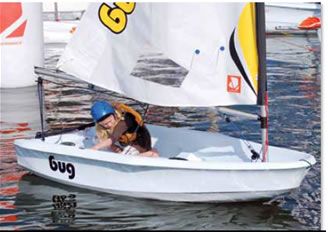
Bug
A pocket-sized club trainer, the Bug is an evolution of the kids trainer/club racer that leverages lessons learned in Optis, Dyers, and Sabots. It pulls together the logic of a stable hull shape and simple-to-sail rig, and puts it all in a cost-effective package.
Lending to its success is designer Jo Richardss ergonomic, roto-molded hull, a fabrication that is as close to zero maintenance as a boat can get. The straight out-of-the-mold polyethylene skin gets a few decals, and theres no wood to refinish or gelcoat to wax. These tough, abrasion-resistant hulls have a bumper boat tolerance thats a big plus when it comes to kids learning to sail. Best of all, owners can start with a learn-to-sail rig and upgrade to a more performance-oriented mast and sail package (41 or 56 square feet) that kicks performance into the fast lane.
Oars and an outboard motor bracket can be added to turn the little sailboat into a dual-purpose dinghy. Even the bow painters means of attachment makes sense-no projecting hardware ready to knick the topsides of unintended contacts. Instead, theres a recessed hole in the stem allowing a line to be lead through and a knot used to keep the painter in place.
Bottom line: Aimed at club programs and families look for boats that can be transported on the car top, the Bug is easy to rig and definitely kid friendly. The fact that its manufacturer, Laser Performance, is an international interest and a major player in the performance dinghy industry means that this boat and its parts will be around for a while.
Photo courtesy of Hobie Cat Co.
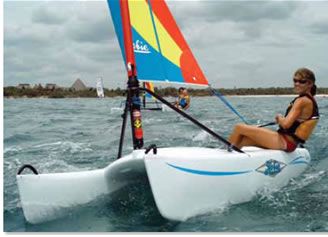
Eastport Pram
Chesapeake Light Craft expedites boatbuilding for do-it-yourselfers looking to take their garage-built boats for a sail. The company pre-cuts parts, packs kits with all the materials, epoxy, and paint youll need, and leads homebuilders through a thoroughly detailed stitch-and-glue approach to assembly. Kits are available in various stages of completeness, ranging from plans only to the full package, including sail, hardware, running rigging, and paint.
The Eastport Pram is just shy of 8 feet, and the marine plywood and epoxy construction delivers a boat that weighs in, sans sailing rig, at just 62 pounds. Lighter than the comparatively sized Bug, this stiff, durable dinghy, rows like a real boat and sails comfortably with one or two aboard. In keeping with other good tender attributes, the Pram behaves under tow and is equally amicable when propelled by a small outboard or tacked up an estuary under sail.
Kit boatbuilding continues to have a niche following. Theres also an added-value feature worth noting: On one hand, the builder receives a box of pieces and the result of his or her endeavor leads to an aesthetic and utilitarian dinghy. In addition, the DIY skills the builder develops will be useful in other epoxy bonding, brightwork, or mono-urethane application projects. Such talents will benefit many other boat maintenance endeavors.
Whats hard to quantify is the sense of accomplishment derived from sailing a boat that you have built yourself. When the project is tackled in tandem with a child, spouse, or friend, the memories and the boat will last.
Bottom line: With neither sidedecks or a sealed hull, this is not a boat thats easy to recover from a capsize. So once the kids favor on-the-edge sailing in a building breeze, a non swamping, easier-righting boat is probably a better option. The Pram can then be put to use by their appreciative parents or grandparents.
Laser
Never in their wildest dreams did Bruce Kirby and Ian Bruce imagine that the Weekender (the Lasers original name) was destined to become an Olympic class sailboat and one of the most popular springboards for top-tier sailors in the world today. Originally envisioned as a car-topper for weekend campers, the cat-rigged, low freeboard sailing dinghy morphed from its original roots into a boat favored by college competitors and revered by generations of agile sailors of all ages. Even frostbiting winter sailors have locked onto the Laser.
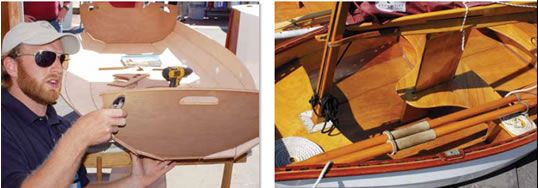
Designed in 1969, the Lasers first few years were anything but smooth sailing. Popularity grew quickly, but along with the limelight came plenty of consternation. Dubbed a surfboard not a sailboat by a growing cross-section of the yachting elite-many parents warned junior sailors to steer as clear of Lasers as they did sex, drugs and rock-n-roll. The campaign failed, and junior sailors in yacht club programs around the country fell into the grip of the new one-design dinghy-discovering the sailboats proclivity to plane.

Dyer Dhows languished in boat sheds across the country as a new theme in sailing took hold. Dubbed fast is fun by sailor/engineer Bill Lee, the young Merlin of Santa Cruz, Calif., took the theme to big-boat sailing, merging California culture with the Laser logic of light displacement and planing hull shapes.
Best of all, the Laser embraced the ideal of a tightly controlled one-design class that put people on the water in identical boats and left winning and losing races up to sailing skill and tactics rather than a boats performance edge. For decades, the boat has been the single-handed sailors choice among junior sailing programs, and with the addition of the Radial, 4.7 and M rigs, smaller competitors have also found the boat to be a great sailing platform. Today, theres some lawyer saber-rattling over the sale of the design rights, but the boat remains more popular than ever.
The sleeved sail, two-part spar, daggerboard, and kick-up rudder make the boat a quick-to-rig and fast-to-get underway dinghy. Light-air efficiency is good for a one-design sailboat, but this means that as the breeze builds, the non-reefable sail can become a handful in a hurry. In fact, the boats Dr. Jekyll-and-Mr. Hyde demeanor is what builds talent among Laser practitioners. The big boys block the mainsail and blast off for the layline, while lighter sailors heavy-weather tactics include more nuanced de-powering and feathering. In light air, the tables turn, and the winner is often the sailor who planes quickest on the reaches. The old guards surfboard slam may have held some credence after all.
Bottom line: The Laser is a timeless classic thats easily transported and is built for performance. Its well suited to adrenaline-seeking teens as well as the more fit adult crowd.
Optimist
Designed in 1947 by Floridian Clark Mills, the utilitarian Optimist could be made out of two sheets of plywood-and from its inception, the Optimist was meant to link kids with the water. Slipping into obscurity in the U.S., the little pram found fertile ground to grow in northern Europe. With just a few tweaks, the Scandinavians took Millss lines and parlayed them into whats become the favored junior sailing trainer for kids from Detroit to Timbuktu. Statistics show that there are about 30 builders worldwide putting out approximately 4,000 boats each year. With about 130,000 boats class registered and an estimated 300,000 total hulls built (amateur and pro), theres plenty of reasons to get excited about an Opti.

The example weve chosen is the USA-built McLaughlin boat, both a demonstration of high-quality FRP construction and modern manufacturing techniques. Its also a boat that can be purchased in a range of performance-inducing iterations-upgrades designated as club, intermediate, advanced, and professional versions. Like all performance sailboats, stiffness and strength-to-weight ratio is important. But class rules include a minimum weight, so the most competitive hulls meet the mandatory lower limit but use good engineering and building technique to reinforce the daggerboard slot and mast step and produce overall stiffness.
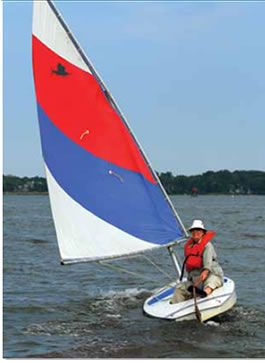
The low mast height and high aspect ratio sprit sail is very versatile, affording young (and small, 65 to 130 pounds) sailors a wide window of decent performance. The flat bottom, slab-sided hull is responsive to crew weight-driven trim changes, and the better the sailor, the more agile they become. Light-air performance is all about minimizing wetted surface and maximizing sail area projection. When the breeze starts to kick up, the sailor becomes the ballast, and the art of hiking, sheet handling, and tiller wiggling come into play.
Under careful adult supervision, two 6- to 8-year-olds can double-hand the friendly little dinghy, or one more-confident child can solo sail it. In fact, introducing kids to sailing with similar proportioned small prams has been a right of passage around for decades. A set of oarlock gudgeons can turn the pram into a functional dinghy thats also adaptable to the smaller Torqeedo outboard (www.torqeedo.com).
McLaughlin also markets a Roto-molded polyethylene version of the Opti and sells DIY kits for those who want to create their own wood version.
Bottom line: The Opti is like a first bicycle without the need for training wheels. The fact that at the last Olympics, over 80 percent of the winning sailors had gotten their start in an Optimist speaks well to the value of messing around in this particular dinghy.

Sunfish
Designed in 1951 by ice boaters Alexander Bryan and Cortland Heyniger, the hard chine Sunfish was the prototype board boat. In 1959, it made the transition into fiberglass, and over the following half-century, more than a quarter-million hulls would hit the water. Simplicity and decent sailing attributes combined with an attractive price to make the Sunfish the most popular one-design dinghy ever raced.
Far more than a platform for racers, these boats are an excellent training tool for sailors of all ages. Also built by Laser Performance, they reflect the fun of summer and put sailors in close contact with the water on which they sail. Its no surprise that the larger fleets coincide with warm water and many see going for a swim to be part and parcel of the low-freeboard experience.
The lateen rig is in keeping with the overall design concept and simplifies rigging. A short stub of a mast is stepped and a single halyard hoists the sail along with tilting V-shaped upper and lower booms.
The total sail area is nearly the same as the Laser, but the halyard hoist versatility of the lateen rig make it a handy beach boat and a little less daunting when the wind begins to build. The clean sail shape on one tack and deformation caused by the mast on the other tack are a slight drawback. The Laser rig is more efficient, but when caught out in a squall, its nice to be able to ease the halyard and dump the sail. Its also handy to be able to leave the boat tethered to a mooring, and the doused sail and short mast make it possible.
Multiple generations of sailors are often found sailing Sunfish, and the boat represents one of the best bargains to be found in the used boat market. When considering a pre owned boat, the potential buyer needs to take a close look at the daggerboard-to-hull junction and mast step, points where previous damage can create hard-to-fix leaks.
Bottom line: The Sunfish is a great beach boat that can turn a hot afternoon into a fun-filled water experience.
Conclusion
There were no losers in this group, and picking winners and runners-up proved a difficult task. The outcome had to be based on assumptions about how these boats would be used. For example, parents with a competitive 9-year-old who swims like a fish, always sprints for the head of the lunch line, and likes to steal bases in Little League probably have an Opti racer in the making. Less competitive junior sailors-future cruisers in the making-will do better learning aboard a Bug. Many newly formed sailing clubs target the boat as their trainer of choice.
The Bravo holds plenty of appeal for those with a lakeside cottage or a favored campground destination. Whether its a solo sail just before sunset or a fun race on Sunday, the quick to set up and put away features are a plus, and for those who feel that two hulls are better-the Bravo will hold plenty of appeal.
Serious competitors can campaign a Laser for life, and whether youre headed for a local district regatta or getting ready for the Olympic trials, the hull, rig, and sail remains identical-sort of like the Monaco Grand Prix being raced in a street legal Mustang.
Bic Opens new little speedster tickled our fancy, and as a trainer/performance boat crossover, it drew a strong nod of approval. Watching the junior sailors smiles as they sailed their Open Bics endorsed our opinion.
And if there is any boat that defines the essence of summer, the Sunfish takes the prize.



































